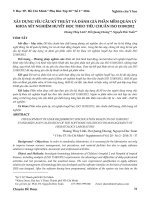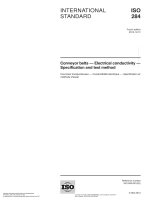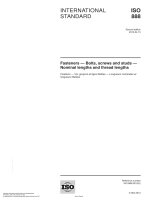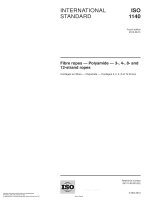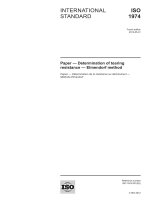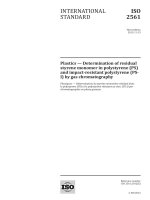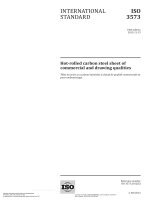Tiêu chuẩn iso 16384 2012
Bạn đang xem bản rút gọn của tài liệu. Xem và tải ngay bản đầy đủ của tài liệu tại đây (256.36 KB, 18 trang )
ISO
16384
First edition
2012-11-01
Refrigerated hydrocarbon and nonpetroleum based liquefied gaseous
fuels — Dimethylether (DME) —
Measurement and calculation on
board ships
Hydrocarbures réfrigérés et combustibles gazeux liquéfiés à base
non pétrolière — Diméthyléther (DME) — Mesurage et calculs à
bord des navires
Reference number
ISO 16384:2012(E)
Copyright International Organization for Standardization
Provided by IHS under license with ISO
No reproduction or networking permitted without license from IHS
Licensee=University of Alberta/5966844001, User=sharabiani, shahramfs
Not for Resale, 12/03/2013 08:28:43 MST
© ISO 2012
--`,`,,,,,```,````,`,,`,`````-`-`,,`,,`,`,,`---
INTERNATIONAL
STANDARD
ISO 16384:2012(E)
COPYRIGHT PROTECTED DOCUMENT
© ISO 2012
All rights reserved. Unless otherwise specified, no part of this publication may be reproduced or utilized in any form or by any
means, electronic or mechanical, including photocopying and microfilm, without permission in writing from either ISO at the
address below or ISO’s member body in the country of the requester.
ISO copyright office
Case postale 56 • CH-1211 Geneva 20
Tel. + 41 22 749 01 11
Fax + 41 22 749 09 47
Web www.iso.org
Published in Switzerland
ii
Copyright International Organization for Standardization
Provided by IHS under license with ISO
No reproduction or networking permitted without license from IHS
--`,`,,,,,```,````,`,,`,`````-`-`,,`,,`,`,,`---
© ISO 2012 – All rights reserved
Licensee=University of Alberta/5966844001, User=sharabiani, shahramfs
Not for Resale, 12/03/2013 08:28:43 MST
ISO 16384:2012(E)
Contents
Page
Foreword ........................................................................................................................................................................................................................................ iv
Introduction..................................................................................................................................................................................................................................v
2
3
4
5
6
7
8
9
10
11
12
Scope ................................................................................................................................................................................................................................. 1
Terms and definitions ..................................................................................................................................................................................... 1
Characteristics and properties of DME ......................................................................................................................................... 2
3.1
General ........................................................................................................................................................................................................... 2
3.2
General characteristics..................................................................................................................................................................... 2
3.3
Chemical and physical properties .......................................................................................................................................... 2
General precautions.......................................................................................................................................................................................... 3
4.1
General ........................................................................................................................................................................................................... 3
4.2
Equipment precautions ................................................................................................................................................................... 3
Tank capacity table ............................................................................................................................................................................................ 4
5.1
General ........................................................................................................................................................................................................... 4
5.2
Contents of tank capacity table................................................................................................................................................. 4
Level gauges............................................................................................................................................................................................................... 4
6.1
Type of level gauges ............................................................................................................................................................................ 4
6.2
Accuracy of level gauge .................................................................................................................................................................... 4
6.3
Use of designated level gauge..................................................................................................................................................... 5
Temperature measuring equipment ............................................................................................................................................... 5
7.1
Type of temperature sensor ........................................................................................................................................................ 5
7.2
Accuracy of temperature measuring equipment ....................................................................................................... 5
7.3
Number and position of temperature sensors ............................................................................................................ 5
Pressure gauge ....................................................................................................................................................................................................... 5
8.1
Type and number of pressure gauges ................................................................................................................................. 5
8.2
Accuracy of pressure gauge ......................................................................................................................................................... 5
Preparation for custody transfer......................................................................................................................................................... 6
9.1
Facilities for cargo operation ...................................................................................................................................................... 6
9.2
Pipelines ....................................................................................................................................................................................................... 6
9.3
Ship/shore meeting ............................................................................................................................................................................ 6
Custody transfer measurement............................................................................................................................................................. 7
10.1 General ........................................................................................................................................................................................................... 7
10.2 Measurement of liquid level ........................................................................................................................................................ 7
10.3 Measurement of temperature .................................................................................................................................................... 7
10.4 Measurement of vapour pressure .......................................................................................................................................... 7
Quantitative calculation................................................................................................................................................................................ 8
11.1 General ........................................................................................................................................................................................................... 8
11.2 Concept of quantitative calculation....................................................................................................................................... 8
Preparation for sailing ................................................................................................................................................................................... 9
12.1 Pipelines and other facilities....................................................................................................................................................... 9
12.2 Ship/shore meeting ............................................................................................................................................................................ 9
12.3 Information to cargo receiver .................................................................................................................................................... 9
Annex A (informative) Estimation of density of DME .......................................................................................................................10
Bibliography ............................................................................................................................................................................................................................. 11
© ISO 2012 – All rights reserved
Copyright International Organization for Standardization
Provided by IHS under license with ISO
No reproduction or networking permitted without license from IHS
Licensee=University of Alberta/5966844001, User=sharabiani, shahramfs
Not for Resale, 12/03/2013 08:28:43 MST
iii
--`,`,,,,,```,````,`,,`,`````-`-`,,`,,`,`,,`---
1
ISO 16384:2012(E)
ISO (the International Organization for Standardization) is a worldwide federation of national standards
bodies (ISO member bodies). The work of preparing International Standards is normally carried out
through ISO technical committees. Each member body interested in a subject for which a technical
committee has been established has the right to be represented on that committee. International
organizations, governmental and non-governmental, in liaison with ISO, also take part in the work.
ISO collaborates closely with the International Electrotechnical Commission (IEC) on all matters of
electrotechnical standardization.
International Standards are drafted in accordance with the rules given in the ISO/IEC Directives, Part 2.
The main task of technical committees is to prepare International Standards. Draft International
Standards adopted by the technical committees are circulated to the member bodies for voting.
Publication as an International Standard requires approval by at least 75 % of the member bodies
casting a vote.
Attention is drawn to the possibility that some of the elements of this document may be the subject of
patent rights. ISO shall not be held responsible for identifying any or all such patent rights.
ISO 16384 was prepared by Technical Committee ISO/TC 28, Petroleum products and lubricants,
Subcommittee SC 5, Measurement of refrigerated hydrocarbon and non-petroleum based liquefied gaseous fuels.
iv
Copyright International Organization for Standardization
Provided by IHS under license with ISO
No reproduction or networking permitted without license from IHS
© ISO 2012 – All rights reserved
Licensee=University of Alberta/5966844001, User=sharabiani, shahramfs
Not for Resale, 12/03/2013 08:28:43 MST
--`,`,,,,,```,````,`,,`,`````-`-`,,`,,`,`,,`---
Foreword
ISO 16384:2012(E)
Introduction
Measures for environmental protection are required on a global scale. In this connection, various
methods of achieving these aims have been independently studied or undertaken in many countries.
One such project, the development of the use of dimethylether (DME) as a new form of energy has been
undertaken in several countries. Use of DME generates neither sulfur-oxide nor any other particulate
matter known to cause environmental pollution at the time of combustion.
Another benefit of the use of DME as a petroleum alternative is that it can be produced easily from
natural gases, coals and biomasses with only slight additional development of the existing techniques of
production, transportation, storage and consumption.
In international trade, liquefied gases in bulk are carried by specialized ships which are equipped with
fully refrigerated or semi-refrigerated type tanks, or pressurized type tanks. For assessing the quantity,
measurement on board these ships is preferable because shore tanks at loading/discharging ports usually
engage in transferring to/from tank cars by pipelines, etc. simultaneously with the delivery/receipt of
the cargo to/from the ships.
To prevent dispute over the delivered quantity of DME, uniform practice of volumetric measurement
and consequent calculation methods is called for.
--`,`,,,,,```,````,`,,`,`````-`-`,,`,,`,`,,`---
Since detailed requirements on installation, calibration and verification of level gauges and thermometers
are standardized in their own respective International Standards, this International Standard focuses
on the practice of custody transfer and subsequent calculation of DME.
© ISO 2012 – All rights reserved
Copyright International Organization for Standardization
Provided by IHS under license with ISO
No reproduction or networking permitted without license from IHS
Licensee=University of Alberta/5966844001, User=sharabiani, shahramfs
Not for Resale, 12/03/2013 08:28:43 MST
v
--`,`,,,,,```,````,`,,`,`````-`-`,,`,,`,`,,`---
Copyright International Organization for Standardization
Provided by IHS under license with ISO
No reproduction or networking permitted without license from IHS
Licensee=University of Alberta/5966844001, User=sharabiani, shahramfs
Not for Resale, 12/03/2013 08:28:43 MST
INTERNATIONAL STANDARD
ISO 16384:2012(E)
Refrigerated hydrocarbon and non-petroleum based
liquefied gaseous fuels — Dimethylether (DME) —
Measurement and calculation on board ships
1 Scope
This International Standard provides guidance on the practices for custody transfer of dimethylether
(DME) on board ships, at both the loading and the discharging ports. It covers such aspects of volumetric
calculation on board as measurement of liquid volume, vapour volume, temperature and pressure; and
accounting for the total quantity of DME on board before and after loading/discharging, regardless of
the type of ship’s tank.
2 Terms and definitions
For the purposes of this document, the following terms and definitions apply.
2.1
absolute pressure
pressure in excess of a perfect vacuum, equal to the algebraic sum of atmospheric pressure and
effective pressure
2.2
automatic tank gauge
ATG
instrument that continuously measures liquid height (dip or ullage) in storage tanks
[ISO 18132-1:2011, definition 2.1.1 and ISO 18132-3:2011, definition 2.1.1]
NOTE 1
An automatic tank gauge usually includes a level sensor, a gauge head and associated mounting
hardware, and in some cases local display.
Automatic tank gauges are also known as automatic level gauges (ALGs).
2.2.1
float-type ATG
ATG that uses a float to detect the liquid level
[ISO 18132-1:2011, definition 2.1.5 and ISO 18132-3:2011, definition 2.1.4]
--`,`,,,,,```,````,`,,`,`````-`-`,,`,,`,`,,`---
NOTE 2
NOTE
The float is guided by a tape or wire that is connected to a drum or a ratchet in the gauge head, where
the level measured is displayed locally and/or remotely.
2.2.2
magnetic-type ATG
ATG that measures the liquid level by magnetic reed switches with a float sensor including magnets, or
by magneto-strictive principle
[ISO 18132-3:2011, definition 2.1.7]
© ISO 2012 – All rights reserved
Copyright International Organization for Standardization
Provided by IHS under license with ISO
No reproduction or networking permitted without license from IHS
1
Licensee=University of Alberta/5966844001, User=sharabiani, shahramfs
Not for Resale, 12/03/2013 08:28:43 MST
ISO 16384:2012(E)
2.2.3
radar-type ATG
microwave-type ATG
ATG that utilizes an antenna to transmit electromagnetic continuous waves toward the liquid in a tank,
and to receive electromagnetic waves which are reflected at the surface of the liquid
[ISO 18132-1:2011, definition 2.1.7 and ISO 18132-3:2011, definition 2.1.8]
2.3
custody transfer
measurement of liquid level, liquid and vapour temperature, and vapour pressure of the DME to be
delivered to/from a tank, by which volume and other data are determined as the basis of payment or the
assessment of duty
2.3.1
closing custody transfer
custody transfer implemented after loading or discharging cargo from the tank(s)
2.3.2
opening custody transfer
custody transfer implemented before loading or discharging cargo from the tank(s)
2.4
heel
amount of cargo retained in a cargo tank prior to loading or after discharge
[ISO 10976:2012, definition 3.1.16]
2.5
saturated vapour pressure
vapour pressure
pressure exerted by the vapour above the liquid in equilibrium at a given temperature
3 Characteristics and properties of DME
3.1 General
DME has the following typical characteristics and properties (see ISO 29945), in consideration of which,
safety precautions should be taken.
3.2 General characteristics
DME has the following general characteristics, which should be considered with respect to personal
safety precautions:
a)
non-corrosive;
c)
acts as an effective solvent of many materials;
b) relatively small temperature coefficient of volume expansion;
d) hydrophilic.
--`,`,,,,,```,````,`,,`,`````-`-`,,`,,`,`,,`---
3.3 Chemical and physical properties
DME has the following general chemical and physical characteristics:
a)
boiling point: −25,1 °C at atmospheric pressure;
b) saturated vapour pressure: 0,61 MPa at 25 °C;
2
Copyright International Organization for Standardization
Provided by IHS under license with ISO
No reproduction or networking permitted without license from IHS
© ISO 2012 – All rights reserved
Licensee=University of Alberta/5966844001, User=sharabiani, shahramfs
Not for Resale, 12/03/2013 08:28:43 MST
ISO 16384:2012(E)
c)
explosive range: 3,4 volume % to 27,0 volume %;
e)
liquid density: 677 kg/m3 at 15 °C.
d) relative gas density: 1,59 relative to air;
4 General precautions
4.1 General
Nothing contained in this International Standard is intended to supersede any regulatory requirements
or recommended operating practices issued by organizations such as the International Maritime
Organization (IMO), International Chamber of Shipping (ICS), Oil Companies International Marine
Forum (OCIMF), International Association of Classification Societies (IACS) and individual operating
companies, nor is this International Standard intended to conflict with any safety or environmental
considerations, local regulations, or the specific provisions of any contract.
4.2 Equipment precautions
4.2.1
Accuracy inspection and verification of gauges
Level gauges, temperature measuring equipment and pressure gauges to be used for custody transfer
shall be subject to accuracy inspection at the time of installation on board and at subsequent periodic
inspections as required by regulation and/or the sales contract.
Certificates of these accuracy verifications shall document the inaccuracies of gauges and provide
statements with regard to their operational condition and suitability for use. They shall be dated and
indicate the person and company performing the verification. The most current certificate(s) shall be
kept on board for inspection by any party to subsequent custody transfer operations.
4.2.2
Maintenance of gauges
Level gauges, temperature measuring equipment and pressure gauges shall be maintained by ship’s
personnel so as to guarantee effective cargo control and accurate custody transfer.
4.2.3
Operation of gauges
Level gauges, temperature measuring equipment and pressure gauges shall be operated by ship’s
personnel designated by the shipmaster.
4.2.4
Malfunction of gauges
In the event that a level gauge, temperature measuring equipment or a pressure gauge malfunctions
during a voyage, the shipmaster shall endeavour to repair it and report the incident and outcome of any
actions taken at the destination without delay.
4.2.5
Tolerance of gauges against cargo nature
--`,`,,,,,```,````,`,,`,`````-`-`,,`,,`,`,,`---
In accordance with the type of tank, i.e. fully refrigerated, semi-refrigerated or fully pressurized, level
gauges, temperature measuring equipment and pressure gauges shall be designed to withstand low
temperatures or high pressure as well the solubility of DME.
4.2.6
Change of gauges
Any changes to level gauges, temperature measuring equipment and pressure gauges require the
approval of the ship’s flag administration and/or classification society, and require external verification
© ISO 2012 – All rights reserved
Copyright International Organization for Standardization
Provided by IHS under license with ISO
No reproduction or networking permitted without license from IHS
3
Licensee=University of Alberta/5966844001, User=sharabiani, shahramfs
Not for Resale, 12/03/2013 08:28:43 MST
ISO 16384:2012(E)
of accuracy by a competent metrological authority for DME custody transfer. All described equipment
shall meet minimum requirements as detailed by the ship’s flag administration and classification society.
4.2.7
Use of other type of gauge
Level gauges, temperature measuring equipment and pressure gauges including those which use
measurement technologies not described in this International Standard are considered acceptable
for use in DME custody transfer service if they are judged to be compatible with those gauges in this
International Standard by the parties to the sales contract of DME, and approval by national regulations.
5 Tank capacity table
5.1 General
Static measurement of DME in a ship’s tank requires determination of liquid level expressed as innage or
ullage, average temperature of liquid and vapour, and vapour pressure. The volume of the liquid is given
by the ship’s tank capacity table; the volume of vapour is calculated by subtracting the liquid volume
from the full capacity of the tank.
5.2 Contents of tank capacity table
Regardless of the type of cargo tanks, ship’s tank capacity tables shall contain the following:
a)
calibration certificate, issued by a qualified calibration organization, which states uncertainty of
the tank calibration;
c)
volume in terms of cubic metres with three decimal places corresponding to the innage or ullage
expressed in centimetres or millimetres between bottom datum point and tank top;
e)
example of the use of tank capacity table;
b) location of level gauges in relation to cargo tank geometry;
d) reference temperature and full capacity of the tank including top dome;
trim and list correction tables;
--`,`,,,,,```,````,`,,`,`````-`-`,,`,,`,`,,`---
f)
g) thermal correction table and density correction table for float-type ATG where applicable;
h) table of volume corrections due to thermal contraction of tank material in the case of fully
refrigerated or semi-refrigerated tanks.
6 Level gauges
6.1 Type of level gauges
Ships with fully refrigerated or semi-refrigerated tanks are usually equipped with radar-type, floattype or magnetic-type ATGs whereas ships with pressurized tanks are usually equipped with float-type
or magnetic-type ATGs or slip-tubes (see ISO 18132-3).
6.2 Accuracy of level gauge
Accuracy of a level gauge depends much on the type of the gauge. ISO 18132-3 requires the accuracy of a
level gauge to be better than ±10 mm with minimum resolution of 1 mm throughout the measuring range.
It should be noted that the accuracy stated on the accuracy certificate is the accuracy defined at the time of
accuracy verification under atmospheric conditions, not the accuracy at time of use under service conditions.
4
Copyright International Organization for Standardization
Provided by IHS under license with ISO
No reproduction or networking permitted without license from IHS
© ISO 2012 – All rights reserved
Licensee=University of Alberta/5966844001, User=sharabiani, shahramfs
Not for Resale, 12/03/2013 08:28:43 MST
ISO 16384:2012(E)
6.3 Use of designated level gauge
Where two sets of level gauges are installed in a cargo tank, they shall be designated as the primary
level gauge and the secondary level gauge. Functioning of a primary level gauge may be monitored by the
corresponding secondary level gauge, and vice versa; however, it is recognized that such a comparison
cannot verify the accuracy of a level gauge to ensure it meets the tolerance. Nevertheless, cross-checking
and tracking of the history provide an indication of the performance of the level gauges on the ship.
7 Temperature measuring equipment
7.1 Type of temperature sensor
Temperature measuring equipment consists of temperature sensors fitted in the tanks and display
apparatus located on deck or in the cargo control room.
Platinum resistance thermometers are commonly used as temperature sensors (see ISO 8310). However,
other types of sensors can be seen in the measurement of DME on board ships.
It should be noted that the accuracy stated on the accuracy certificate is the accuracy defined at the
time of accuracy verification where the sensors are inspected as a part of the temperature measuring
equipment. Accordingly, when one of the sensors is replaced, the display unit shall be adjusted for the
new sensor and the results be verified.
Performance criteria of temperature measurement equipment are established in International
Standards, government regulations, the sales contract, the manufacturer’s instructions and calibration
certificates. In the absence of specified tolerances to be referred to, the accuracy of the temperature
measuring equipment, regardless of the type of the sensor, should be better than ± 0,5 °C with the
minimum resolution of 0,1 °C (see ISO 8310) covering between −50 °C and 30 °C.
7.3 Number and position of temperature sensors
In the cargo tank, at least one sensor shall be mounted in a position which is always occupied by the
vapour irrespective of loading condition. Multiple sensors should be mounted vertically in the cargo
tank to measure the liquid temperature, one of which shall be mounted as near to the tank bottom as
possible to measure the temperature of the heel.
8 Pressure gauge
8.1 Type and number of pressure gauges
Any kind of pressure gauge may be used. It may be one consisting of both transmitter and receiver or
with local display only. It also may be one that measures the gauge pressure or absolute pressure.
When a gauge-pressure type pressure gauge is employed for custody transfer, the absolute pressure
shall be calculated by adding the reading of a certified barometer to the reading of the pressure gauge.
A pressure gauge should be installed in each cargo tank to measure the pressure of the cargo tank
vapour space.
8.2 Accuracy of pressure gauge
Performance criteria are established in International Standards, government regulations, the sales
contract and the manufacturer’s instructions. In the absence of specified tolerances to be referred to,
the accuracy of pressure gauges should be within 1 % of their measuring span.
© ISO 2012 – All rights reserved
Copyright International Organization for Standardization
Provided by IHS under license with ISO
No reproduction or networking permitted without license from IHS
5
Licensee=University of Alberta/5966844001, User=sharabiani, shahramfs
Not for Resale, 12/03/2013 08:28:43 MST
--`,`,,,,,```,````,`,,`,`````-`-`,,`,,`,`,,`---
7.2 Accuracy of temperature measuring equipment
ISO 16384:2012(E)
9 Preparation for custody transfer
9.1 Facilities for cargo operation
Functioning of level gauges, temperature measurement equipment and pressure gauges as well as the
various facilities used for cargo operation shall be confirmed with their proper functioning before the
ship’s arrival at the loading/discharging port.
Activities which may affect the measurement of liquid level, temperature and pressure in the cargo
tanks shall be stopped in advance of the custody transfer operation.
9.2 Pipelines
The liquid line and vapour return line shall be connected during the ship/shore meeting for quick dispatch.
The valves of these lines shall be kept closed until the custody transfer measurement has been completed.
The ship’s delivery lines may be full or empty, but they should preferably be in an identical condition
before and after loading/discharging.
9.3 Ship/shore meeting
9.3.1 Prior to loading/discharging, the shipmaster shall hold a meeting to be attended by the
representatives of the ship, terminal and qualified inspection organization. Minutes of the meeting shall
be signed by these attendees.
9.3.2
At the meeting, the ship shall provide or confirm the following information:
a)
names and roles of ship personnel who will be responsible for cargo transfer;
c)
the fact that all necessary ship equipment inspections and tests have been carried out;
e)
the previous three cargoes carried by the ship;
b) pre-arrival instructions on cargo;
d) cargo tank data such as temperatures, pressures, cargo tank quantities, liquid heel and arrival dip,
composition of tank vapour, and total quantity of cargo on board;
f)
ship regulations and emergency procedures with particular attention to emergency shut-down
valve closure times and to the agreed emergency shut-down procedures.
9.3.3
The terminal shall provide or confirm the following information:
a)
names and roles of terminal personnel who will be responsible for cargo transfer;
c)
port and jetty regulations with particular attention to berth operating limits, fire-fighting
capabilities and other emergency procedures.
b) that the relevant terminal equipment is satisfactory and that appropriate inspection checks have
been carried out;
9.3.4
The ship and terminal shall agree on the following:
a)
a common language for communication;
c)
the order of loading/discharging;
b) equipment and procedures for normal and emergency communications;
d) the total quantities of cargo to be transferred;
6
Copyright International Organization for Standardization
Provided by IHS under license with ISO
No reproduction or networking permitted without license from IHS
--`,`,,,,,```,````,`,,`,`````-`-`,,`,,`,`,,`---
© ISO 2012 – All rights reserved
Licensee=University of Alberta/5966844001, User=sharabiani, shahramfs
Not for Resale, 12/03/2013 08:28:43 MST
ISO 16384:2012(E)
e)
f)
the sequence of discharging and receiving tanks;
the intended transfer rates;
g) the transfer temperatures and pressures to be expected;
h) the use of vapour return lines;
i)
any further information or procedures relevant to the operation.
NOTE 1
Adapted from SIGTTO Liquefied gas handling principles on ships and in terminals[8].
NOTE 2
Refer to OCIMF International safety guide for oil tankers and terminals (ISGOTT)[7] for the ship/shore
safety checklist.
10 Custody transfer measurement
10.1 General
Opening custody transfer is implemented immediately before loading or discharging DME. Closing
custody transfer is implemented immediately after loading or discharging. Both custody transfers
include measurement of liquid level, liquid and vapour temperature, and vapour pressure of DME, based
on which the quantity of DME delivered to/from the tanks is determined.
Custody transfer shall be witnessed by an independent qualified inspection organization with or
without representatives from the terminal. Results of the measurement shall be recorded on a blank
form. Measurement shall be performed without interruption.
10.2 Measurement of liquid level
The primary level gauge shall be used for custody transfer measurement unless it is identified as being
out of order. The secondary level gauge shall always be in operational condition.
A sufficient number of measurements shall be made and averaged according to the condition of the liquid
surface. In the case of slip tubes, note that accurate level measurement is achieved only by skilful operation.
Prior to measurement, the settings of the ATG shall be confirmed. For example, the settings of a floattype ATG can be confirmed at the top reference point.
The ship’s draft shall be observed by the ship’s responsible officer for calculation of trim and list
correction. Trim and list may be ascertained by an inclinometer or draft gauge.
10.3 Measurement of temperature
There may be cases in which a measured temperature can be judged to be of liquid or of vapour based
on the temperature itself; however, precise determination requires comparison of the position of the
temperature sensor and the liquid level. In addition, temperature measured by a sensor in the tank
dome should not be taken into account when it is judged to be subject to heat input.
Liquid temperature and vapour temperature at each cargo tank shall be separately averaged.
10.4 Measurement of vapour pressure
Vapour pressure shall be measured by the pressure gauges installed in each cargo tank.
--`,`,,,,,```,````,`,,`,`````-`-`,,`,,`,`,,`---
© ISO 2012 – All rights reserved
Copyright International Organization for Standardization
Provided by IHS under license with ISO
No reproduction or networking permitted without license from IHS
7
Licensee=University of Alberta/5966844001, User=sharabiani, shahramfs
Not for Resale, 12/03/2013 08:28:43 MST
ISO 16384:2012(E)
11 Quantitative calculation
11.1 General
Referring to the ship’s tank capacity table, the independent qualified inspector and ship’s responsible
officer shall calculate the volume and mass of DME in the ship’s tanks from the data collected through
custody transfer measurement. Representatives of the terminal can occasionally participate in the
calculation process. Density of DME, expressed in kilograms per cubic metre to one decimal place, shall
be presented by the loading terminal.
11.2 Concept of quantitative calculation
a)
Using tank capacity tables, calculate the liquid volume in each tank in terms of cubic metres to three
decimal places at the averaged liquid temperature in the tank, applying necessary corrections as
appropriate (see Table 1). Calculate the total mass of DME in liquid state on board in kilograms. The
density of DME at a given temperature may be estimated using the equation presented in Annex A.
b) Calculate total vapour volume (VV ) in each tank by deducting liquid volume at the averaged liquid
temperature from the tanks’ full capacity, then calculate total mass in kilograms of DME in the
vapour state (MV ) on board using the following equation:
M V = VV ×
where
MV
is the mass of DME in the vapour state (kg);
M
is the molecular weight of DME (kg/mol);
VV
TV
PV
is the vapour volume of DME (m3);
is the average vapour temperature (K);
is the vapour pressure (kPaA).
Calculate the total mass in kilograms of DME on board by adding the values obtained in a) and b).
d) Deduct the total mass before loading from that after loading and define the mass of DME loaded on
board or deduct the total mass after discharging from that before discharging and define the mass
of DME discharged.
8
Copyright International Organization for Standardization
Provided by IHS under license with ISO
No reproduction or networking permitted without license from IHS
© ISO 2012 – All rights reserved
Licensee=University of Alberta/5966844001, User=sharabiani, shahramfs
Not for Resale, 12/03/2013 08:28:43 MST
--`,`,,,,,```,````,`,,`,`````-`-`,,`,,`,`,,`---
c)
PV
M
273, 15
×
×
0, 022 4
101, 325
TV
ISO 16384:2012(E)
Table 1 — Corrections required for volumetric calculation
Type of level gauge
Float-type ATG
Magnetic-type ATG
Fully/semi-refrigerated tank
Pressurized-tank
Tape a
Density b
Trim and list c
Tank shrinkage d
Pipe e
Pipe e
Tank shrinkage d
—
Density b
Density b
Trim and list c
Trim and list c
Pipe e
Radar-type ATG
Trim and list c
Slip tube
—
—
Tank shrinkage d
Location f
Trim and list c
a
Correction for expansion/contraction of float tape/wire due to change of vapour temperature.
c
Correction for ship’s trim and list.
b
d
e
f
Correction for buoyancy of float due to change of DME density.
Correction for expansion/contraction of tank due to change of liquid/vapour temperature.
Correction for expansion/contraction of guide pipe due to change of vapour temperature.
Correction for the location of gauging in accordance with liquid level.
12 Preparation for sailing
12.1 Pipelines and other facilities
The refrigeration plant or compressor shall not be operated until custody transfer has completed. Liquid
and vapour return lines shall be disconnected after the completion of custody transfer measurement.
12.2 Ship/shore meeting
After loading/discharging, the shipmaster shall hold a meeting to be attended by the representatives
of the ship, terminal and qualified inspection organization. Minutes of the meeting shall be signed by
these attendees.
12.3 Information to cargo receiver
Cargo information such as the density shall be relayed to the receiver after loading.
--`,`,,,,,```,````,`,,`,`````-`-`,,`,,`,`,,`---
© ISO 2012 – All rights reserved
Copyright International Organization for Standardization
Provided by IHS under license with ISO
No reproduction or networking permitted without license from IHS
9
Licensee=University of Alberta/5966844001, User=sharabiani, shahramfs
Not for Resale, 12/03/2013 08:28:43 MST
ISO 16384:2012(E)
Annex A
(informative)
Estimation of density of DME
Density of dimethylether (DME) at a given temperature may be estimated using the following equation1):
where
d
A
B
C
D
T
A
T D
B ^ 1 + 1 −
C
--`,`,,,,,```,````,`,,`,`````-`-`,,`,,`,`,,`---
d=
is the density (kg/m3);
is equal to 55,600 1;
is equal to 0,236 704;
is equal to 401,406;
is equal to 0,243 367;
is the temperature (K).
1) C. F. Spencer, R. P. Danner, Journal of Chemical & Engineering Data, 17 (1972).
10
Copyright International Organization for Standardization
Provided by IHS under license with ISO
No reproduction or networking permitted without license from IHS
© ISO 2012 – All rights reserved
Licensee=University of Alberta/5966844001, User=sharabiani, shahramfs
Not for Resale, 12/03/2013 08:28:43 MST
ISO 16384:2012(E)
Bibliography
[1]
ISO 8310, Refrigerated hydrocarbon and non-petroleum based liquefied gaseous fuels — General
requirements for automatic tank thermometers on board marine carriers and floating storage
[3]
ISO 18132-1:2011, Refrigerated hydrocarbon and non-petroleum based liquefied gaseous fuels —
General requirements for automatic tank gauges — Part 1: Automatic tank gauges for liquefied
natural gas on board marine carriers and floating storage
[4]
ISO 18132-3:2011, Refrigerated hydrocarbon and non-petroleum based liquefied gaseous fuels —
General requirements for automatic tank gauges — Part 3: Automatic tank gauges for liquefied
petroleum and chemical gases on board marine carriers and floating storage
[5]
ISO 29945, Refrigerated non-petroleum-based liquefied gaseous fuels — Dimethylether (DME) —
Method of manual sampling onshore terminals
[7]
OCIMF. International safety guide for oil tankers and terminals (ISGOTT). 5th Edition
[2]
[6]
[8]
ISO 10976:2012, Refrigerated light hydrocarbon fluids — Measurement of cargoes on board LNG carriers
Spencer C.F., & Danner R.P.J.J. Chem. Eng. Data. 1972, 17
SIGTTO. Liquefied gas handling principles on ships and in terminals. 3rd Edition
--`,`,,,,,```,````,`,,`,`````-`-`,,`,,`,`,,`---
© ISO 2012 – All rights reserved
Copyright International Organization for Standardization
Provided by IHS under license with ISO
No reproduction or networking permitted without license from IHS
11
Licensee=University of Alberta/5966844001, User=sharabiani, shahramfs
Not for Resale, 12/03/2013 08:28:43 MST
ISO 16384:2012(E)
--`,`,,,,,```,````,`,,`,`````-`-`,,`,,`,`,,`---
ICS 75.180.30
Price based on 11 pages
© ISO 2012 – All rights reserved
Copyright International Organization for Standardization
Provided by IHS under license with ISO
No reproduction or networking permitted without license from IHS
Licensee=University of Alberta/5966844001, User=sharabiani, shahramfs
Not for Resale, 12/03/2013 08:28:43 MST
